AUIE–GAN: Adaptive Underwater Image Enhancement Based on Generative Adversarial Networks
Abstract
1. Introduction
2. Related Work
2.1. Enhancement-Based Methods
2.2. Restoration-Based Methods
2.3. Polarization Imaging-Based Methods
2.4. Deep Learning-Based Methods
3. Methods
3.1. Generator Architecture
3.2. Discriminator Architecture
3.3. Loss Functions
4. Experiment
4.1. Datasets and Metrics
4.2. Implementations and Baselines
4.3. Results on Full-Reference Datasets
4.4. Results on Non-Reference Datasets
4.5. Ablation Study
5. Conclusions
Author Contributions
Funding
Institutional Review Board Statement
Informed Consent Statement
Data Availability Statement
Conflicts of Interest
References
- Kocak, D.M.; Dalgleish, F.R.; Caimi, F.M.; Schechner, Y.Y. A focus on recent developments and trends in underwater imaging. Mar. Technol. Soc. J. 2008, 42, 52–67. [Google Scholar] [CrossRef]
- Guo, Y.C.; Li, H.Y.; Zhuang, P.X. Underwater Image Enhancement Using a Multiscale Dense Generative Adversarial Network. IEEE J. Ocean. Eng. 2020, 45, 862–870. [Google Scholar] [CrossRef]
- Goodfellow, I.; Pouget-Abadie, J.; Mirza, M.; Xu, B. Generative adversarial nets. Commun. ACM 2020, 63, 139–144. [Google Scholar] [CrossRef]
- Li, R.; Wu, C.H.; Liu, S.C.; Wang, J. SDP-GAN: Saliency Detail Preservation Generative Adversarial Networks for High Perceptual Quality Style Transfer. IEEE Trans. Image Process. 2021, 30, 374–385. [Google Scholar] [CrossRef] [PubMed]
- Xu, W.H.; Xie, X.H.; Lai, J.H. RelightGAN: Instance-level Generative Adversarial Network for Face Illumination Transfer. IEEE Trans. Image Process. 2021, 30, 3450–3460. [Google Scholar] [CrossRef]
- Wu, J.J.; Liu, X.L.; Lu, Q.H.; Zin, Z. FW-GAN: Underwater image enhancement using generative adversarial network with multi-scale fusion. Signal Process. Image Commun. 2022, 109, 116855. [Google Scholar] [CrossRef]
- Liu, Y.C.; Chan, W.H.; Chen, Y.Q. Automatic white balance for digital still camera. IEEE Trans. Consum. Electron. 1995, 41, 460–466. [Google Scholar]
- Rahman, Z.; Jobson, D.J.; Woodell, G.A. Multi-scale retinex for color image enhancement. In Proceedings of the 3rd IEEE International Conference on Image Processing, Lausanne, Switzerland, 19 September 1996; pp. 1003–1006. [Google Scholar]
- Zuiderveld, K. Contrast limited adaptive histogram equalization. In Graphics Gems IV; Heckbert, P.S., Ed.; Academic Press Professional, Inc.: San Diego, CA, USA, 1994; pp. 474–485. [Google Scholar]
- Li, C.L.; Tang, S.Q.; Kwan, H.K.; Yan, J. Color Correction Based on CFA and Enhancement Based on Retinex With Dense Pixels for Underwater Images. IEEE Access 2020, 8, 155732–155741. [Google Scholar] [CrossRef]
- Hitam, M.S.; Yussof, W.N.J.H.W.; Awalludin, E.A.; Bachok, Z. Mixture Contrast Limited Adaptive Histogram Equalization for Underwater Image Enhancement. In Proceedings of the 2013 International Conference on Computer Applications Technology (ICCAT), Sousse, Tunisia, 20–22 January 2013; IEEE: New York, NY, USA, 2013. [Google Scholar]
- Tang, Z.J.; Jiang, L.Z.; Luo, Z.H. A new underwater image enhancement algorithm based on adaptive feedback and Retinex algorithm. Multimed. Tools Appl. 2021, 80, 28487–28499. [Google Scholar] [CrossRef]
- Li, C.Y.; Guo, J.C.; Cong, R.M.; Wang, B. Underwater Image Enhancement by Dehazing With Minimum Information Loss and Histogram Distribution Prior. IEEE Trans. Image Process. 2016, 26, 5664–5677. [Google Scholar] [CrossRef]
- Zhang, S.; Wang, T.; Dong, J.Y.; Yu, H. Underwater image enhancement via extended multi-scale Retinex. Neurocomputing 2017, 245, 100622. [Google Scholar] [CrossRef]
- Ancuti, C.; Ancuti, C.O.; Haber, T.; Bekaert, P. Enhancing Underwater Images and Videos by Fusion. In Proceedings of the IEEE Conference on Computer Vision and Pattern Recognition (CVPR), New York, NY, USA, 16–21 June 2012; pp. 81–88. [Google Scholar]
- Galdran, A.; Pardo, D.; Picon, A.; Alvarez-Gila, A. Automatic Red-Channel underwater image restoration. J. Vis. Commun. Image Represent. 2015, 26, 132–145. [Google Scholar] [CrossRef]
- Carlevaris-Bianco, N.; Mohan, A.; Eustice, R.M. Initial Results in Underwater Single Image Dehazing. In Proceedings of the Washington State Conference and Trade Center (WSCTC), Seattle, WA, USA, 20–23 September 2010; IEEE: New York, NY, USA, 2010. [Google Scholar]
- Song, W.; Wang, Y.; Huang, D.M.; Tjondronegoro, D. A Rapid Scene Depth Estimation Model Based on Underwater Light Attenuation Prior for Underwater Image Restoration. In Proceedings of the 19th Pacific-Rim Conference on Multimedia (PCM), Hefei, China, 21–22 September 2018; Springer: Berlin, Germany, 2018; pp. 678–688. [Google Scholar]
- He, K.M.; Sun, J.; Tang, X.O. Single Image Haze Removal Using Dark Channel Prior. IEEE Trans. Pattern Anal. Mach. Intell. 2011, 33, 2341–2353. [Google Scholar]
- Drews, P.; do Nascimento, E.; Moraes, F.; Campos, M. Transmission Estimation in Underwater Single Images. In Proceedings of the IEEE International Conference on Computer Vision (ICCV), Sydney, NSW, Australia, 1–8 December 2013; IEEE: New York, NY, USA, 2013; pp. 825–830. [Google Scholar]
- Yang, H.Y.; Chen, P.Y.; Huang, C.C.; Shiau, Y.C. Low Complexity Underwater Image Enhancement Based on Dark Channel Prior. In Proceedings of the 2011 Second International Conference on Innovations in Bioinspired Computing and Applications, Washington, DC, USA, 16–18 December 2011; IEEE: Shenzhen, China, 2011; pp. 17–20. [Google Scholar]
- Wang, N.; Zheng, H.Y.; Zheng, B. Underwater Image Restoration via Maximum Attenuation Identification. IEEE Access 2017, 5, 18941–18952. [Google Scholar] [CrossRef]
- Schechner, Y.Y.; Karpel, N. Clear underwater vision. In Proceedings of the 2004 IEEE Computer Society Conference on Computer Vision and Pattern Recognition (CVPR), Washington, DC, USA, 27 June–2 July 2004. [Google Scholar] [CrossRef]
- Hu, H.; Zhao, L.; Li, X.; Wang, H.; Liu, T. Underwater Image Recovery Under the Nonuniform Optical Field Based on Polarimetric Imaging. IEEE Photonics J. 2018, 10, 1–9. [Google Scholar] [CrossRef]
- Hu, H.; Zhao, L.; Li, X.; Wang, H. Polarimetric image recovery in turbid media employing circularly polarized light. Opt. Express. 2018, 26, 25047–25059. [Google Scholar] [CrossRef] [PubMed]
- Li, X.; Hu, H.; Zhao, L.; Wang, H. Polarimetric image recovery method combining histogram stretching for underwater imaging. Sci. Rep. 2018, 8, 12430. [Google Scholar] [CrossRef] [PubMed]
- Treibitz, T.; Schechner, Y.Y. Active Polarization Descattering. IEEE Trans. Pattern Anal. Mach. Intell. 2009, 31, 385–399. [Google Scholar] [CrossRef]
- Han, P.; Liu, F.; Yang, K.; Ma, J. Active underwater descattering and image recovery. Appl. Opt. 2017, 56, 6631–6638. [Google Scholar] [CrossRef]
- Naik, A.; Swarnakar, A.; Mittal, K. Shallow-UWnet: Compressed Model for Underwater Image Enhancement (Student Abstract). In Proceedings of the 35th AAAI Conference, San Francisco, CA, USA, 9–10 August 2011; Association Advancement Artificial Intelligence: Palo Alto, CA, USA, 2021; pp. 15853–15854. [Google Scholar]
- Guo, C.L.; Wu, R.Q.; Jin, X.; Han, L. Underwater Ranker: Learn Which Is Better and How to Be Better. Available online: https://arxiv.org/abs/2208.06857 (accessed on 18 June 2023).
- Fu, Z.Q.; Wang, W.; Huang, Y.; Ding, X. Uncertainty Inspired Underwater Image Enhancement. In Proceedings of the 17th European Conference on Computer Vision (ECCV), Tel Aviv, Israel, 23–27 October 2022; Springer: Berlin, Germany, 2022; pp. 465–482. [Google Scholar]
- Wang, Y.D.; Guo, J.C.; Gao, H.; Yue, H. UIEC2-Net: CNN-Based Underw. Image Enhanc. Using Two Color Space. Signal Process. Image Commun. 2021, 96, 116250. [Google Scholar] [CrossRef]
- Qi, Q.; Zhang, Y.C.; Tian, F.; Wu, J. Underwater Image Co-Enhancement With Correlation Feature Matching and Joint Learning. IEEE Trans. Circuits Syst. Video Technol. 2022, 32, 1133–1147. [Google Scholar] [CrossRef]
- Li, C.Y.; Guo, J.C.; Guo, C.L. Emerging From Water: Underwater Image Color Correction Based on Weakly Supervised Color Transfer. IEEE Signal Process. Lett. 2018, 25, 323–327. [Google Scholar] [CrossRef]
- Islam, M.J.; Xia, Y.Y.; Sattar, J. Fast Underwater Image Enhancement for Improved Visual Perception. IEEE Robot. Autom. Lett. 2020, 5, 3227–3234. [Google Scholar] [CrossRef]
- Liu, X.D.; Gao, Z.; Chen, B.M. MLFcGAN: Multilevel Feature Fusion-Based Conditional GAN for Underwater Image Color Correction. IEEE Geosci. Remote Sens. Lett. 2020, 17, 1488–1492. [Google Scholar] [CrossRef]
- Ronneberger, O.; Fischer, P.; Brox, T. U-Net: Convolutional Networks for Biomedical Image Segmentation. In Lecture Notes in Computer Science, Proceedings of the Medical Image Computing and Computer-Assisted Intervention (MICCAI), Munich, Germany, 5–9 October 2015; Navab, N., Hornegger, J., Wells, W., Frangi, A., Eds.; Springer: Berlin/Heidelberg, Germany, 2015; Volume 9351. [Google Scholar]
- Huang, J.; Zhu, P.F.; Geng, M.R.; Zhou, X. Range Scaling Global U-Net for Perceptual Image Enhancement on Mobile Devices. In Proceedings of the 15th European Conference on Computer Vision (ECCV), Munich, Germany, 8–14 September 2019; Springer: Berlin, Germany, 2019; pp. 230–242. [Google Scholar]
- Fuoli, D.; Van Gool, L.; Timofte, R. Fourier Space Losses for Efficient Perceptual Image Super-Resolution. In Proceedings of the 18th IEEE/CVF International Conference on Computer Vision (ICCV), Montreal, QC, Canada, 11–17 October 2021; IEEE: New York, NY, USA, 2021; pp. 2340–2349. [Google Scholar]
- Miyato, T.; Kataoka, T.; Koyama, M.; Yoshida, Y. Spectral Normalization for Generative Adversarial Networks. Available online: https://arxiv.org/abs/1802.05957 (accessed on 18 June 2023).
- Wang, Z.; Bovik, A.C.; Sheikh, H.R.; Simoncelli, E.P. Image quality assessment: From error visibility to structural similarity. IEEE Trans. Image Process. 2020, 13, 600–612. [Google Scholar] [CrossRef]
- Ignatov, A.; Kobyshev, N.; Timofte, R.; Vanhoey, K. DSLR-Quality Photos on Mobile Devices with Deep Convolutional Networks. In Proceedings of the 16th IEEE International Conference on Computer Vision (ICCV), Vancouver, BC, Canada, 22–23 September 2017; IEEE: New York, NY, USA, 2017; pp. 3297–3305. [Google Scholar]
- Johnson, J.; Alahi, A.; Li, F.F. Perceptual Losses for Real-Time Style Transfer and Super-Resolution. In Proceedings of the 14th European Conference on Computer Vision (ECCV), Amsterdam, The Netherlands, 8–16 October 2016; Springer: Berlin, Germany, 2016; pp. 694–711. [Google Scholar]
- Li, C.Y.; Guo, C.L.; Ren, W.Q.; Tao, D. An Underwater Image Enhancement Benchmark Dataset and Beyond. IEEE Trans. Image Process. 2020, 29, 4376–4389. [Google Scholar] [CrossRef] [PubMed]
- Hou, G.J.; Zhao, X.; Pan, Z.K.; Li, J. Benchmarking Underwater Image Enhancement and Restoration, and Beyond. IEEE Access 2020, 8, 122078–122091. [Google Scholar] [CrossRef]
- Liu, R.S.; Fan, X.; Zhu, M.; Hou, M. Real-World Underwater Enhancement: Challenges, Benchmarks, and Solutions Under Natural Light. IEEE Trans. Circuits Syst. Video Technol. 2020, 30, 4861–4875. [Google Scholar] [CrossRef]
- Lai, Y.H.; Zhou, Z.; Su, B.H.; Chen, J. Single underwater image enhancement based on differential attenuation compensation. Front. Mar. Sci. 2022, 9, 1047053. [Google Scholar] [CrossRef]
- Huang, S.R.; Wang, K.Y.; Liu, H.; Li, Y. Contrastive Semi-Supervised Learning for Underwater Image Restoration via Reliable Bank. Available online: https://arxiv.org/abs/2303.09101 (accessed on 18 June 2023).
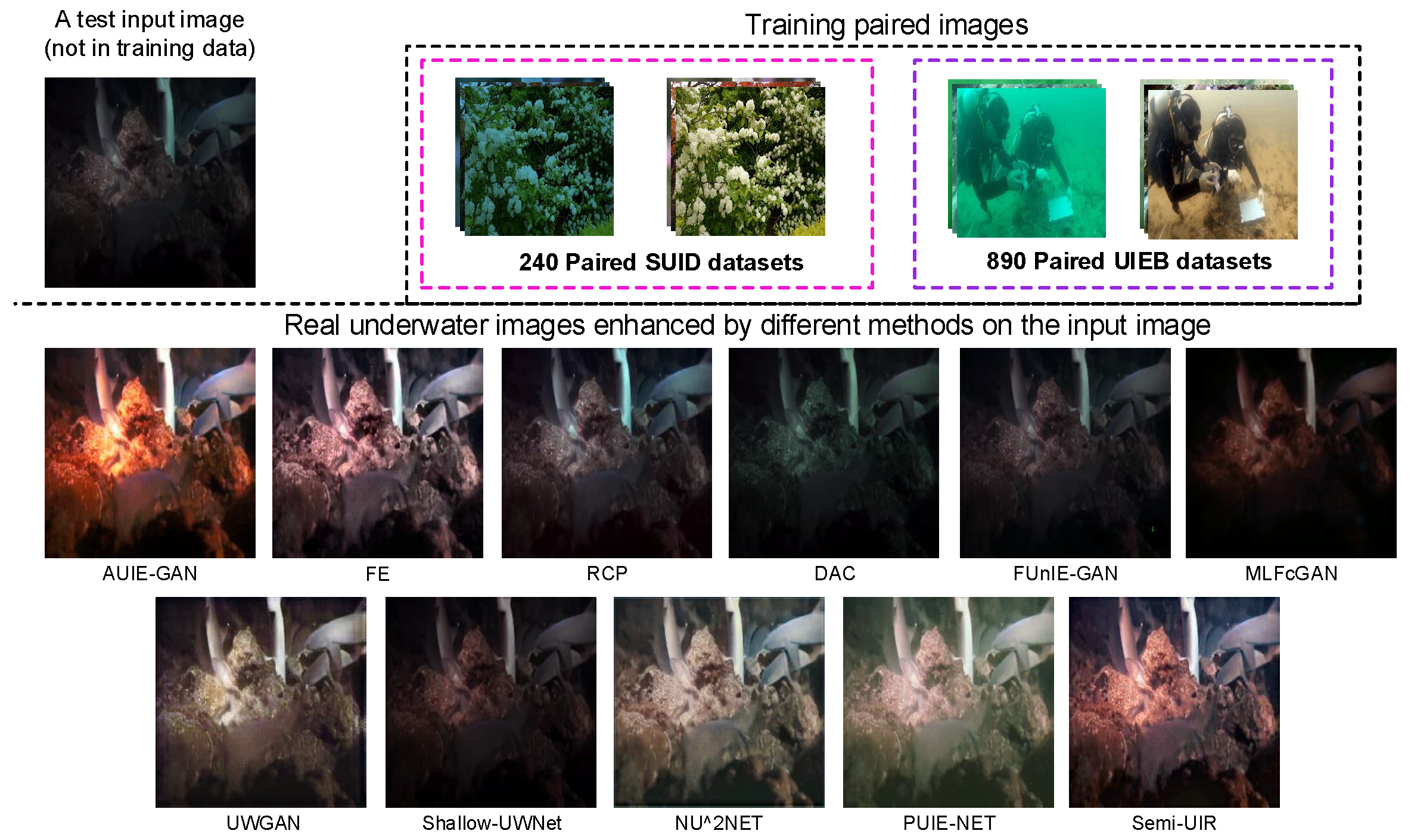


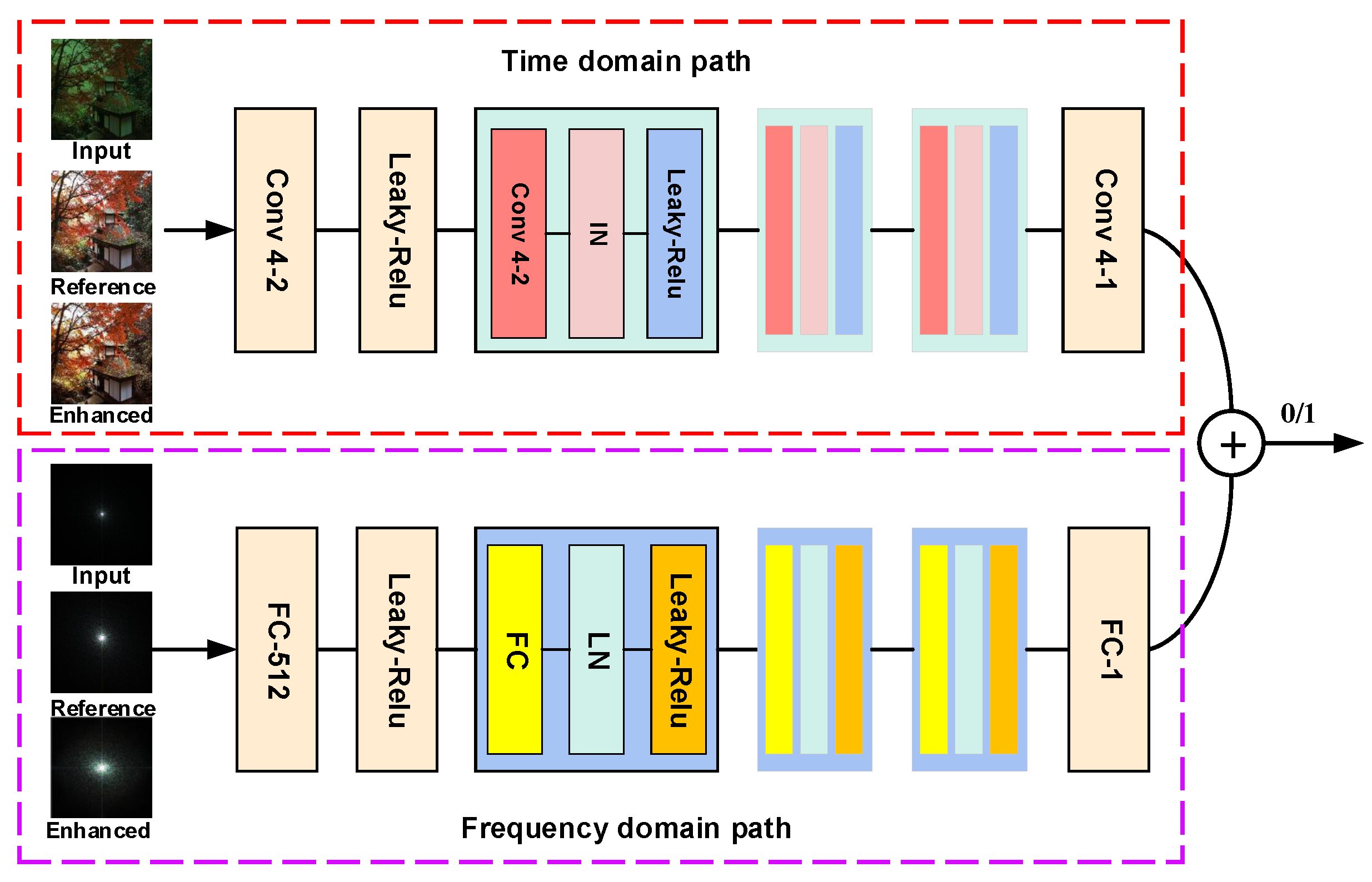


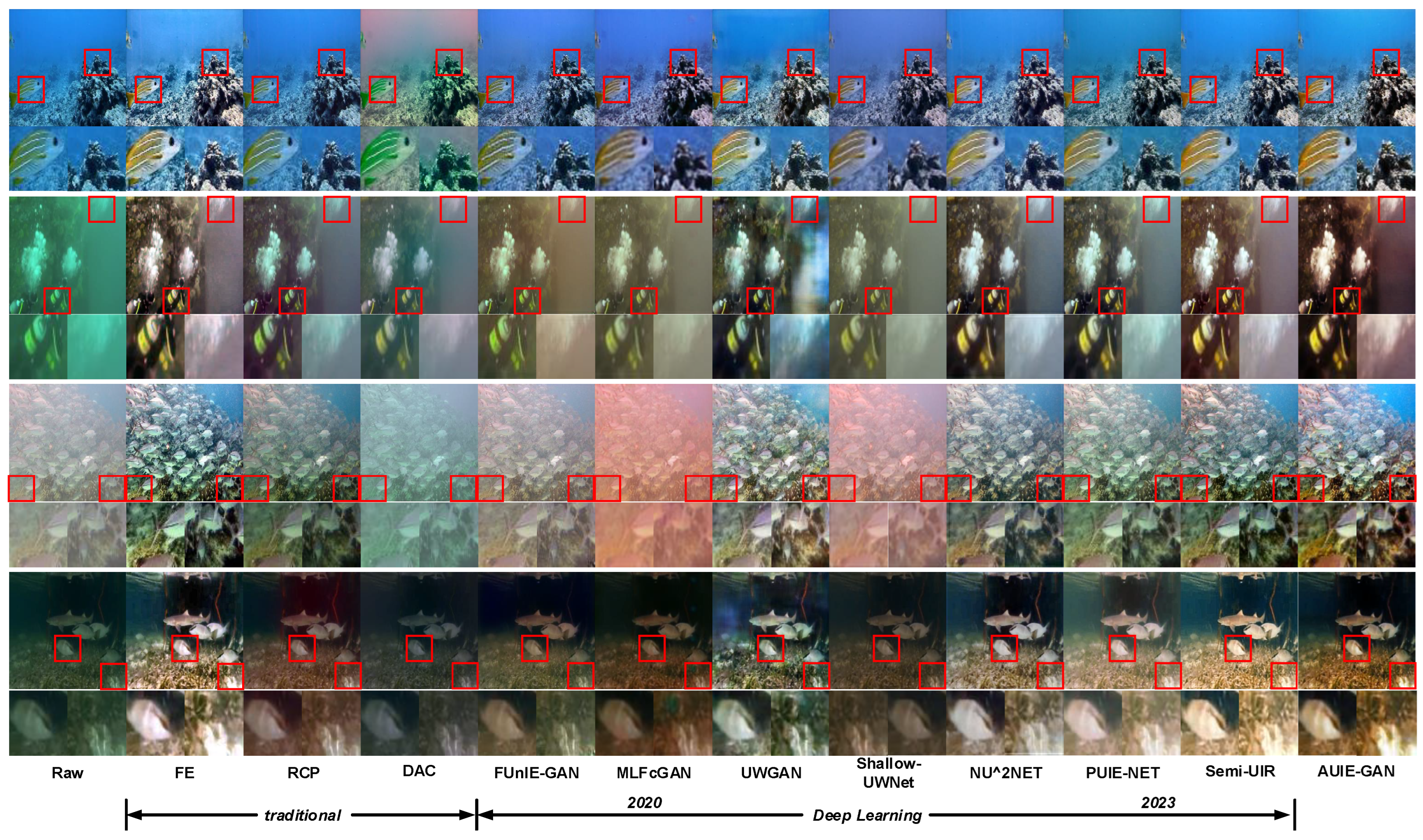
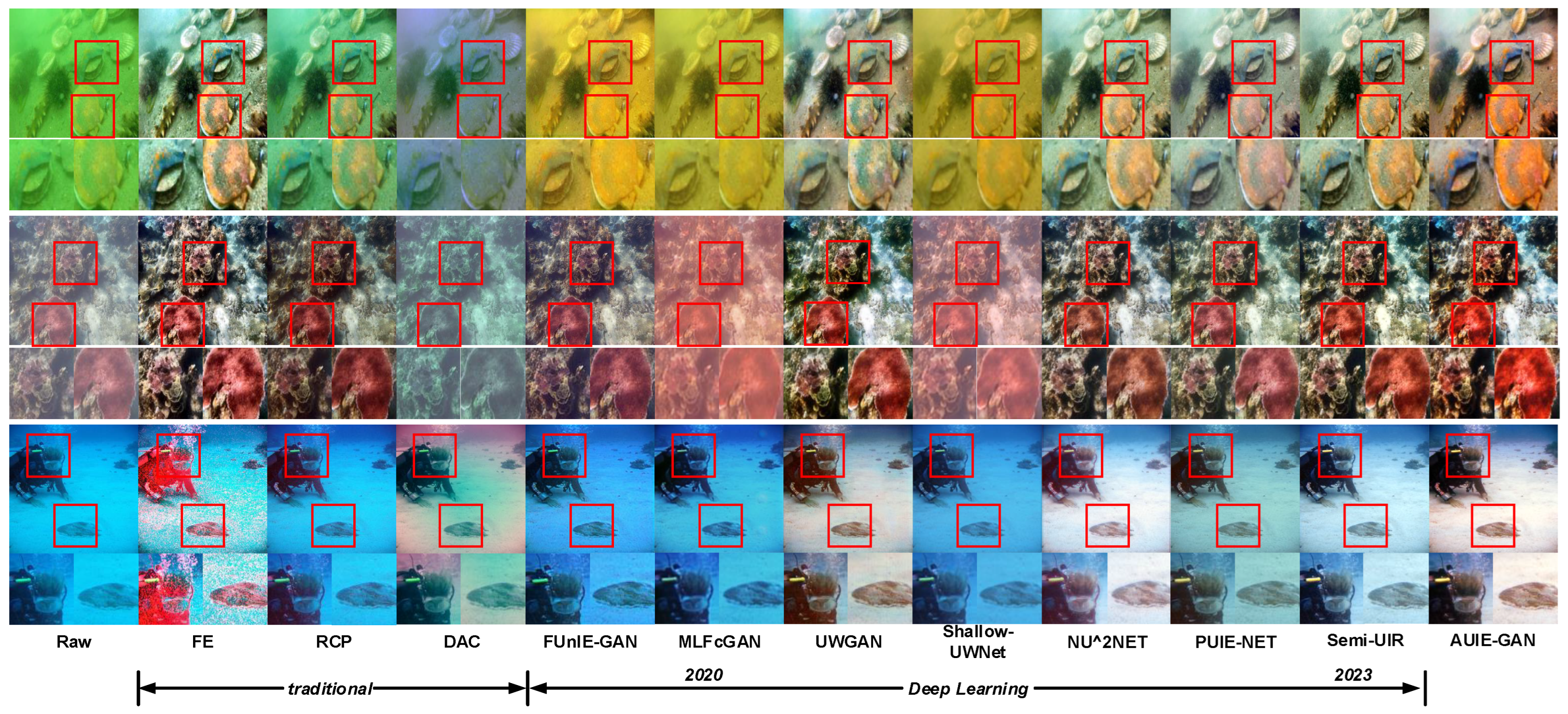
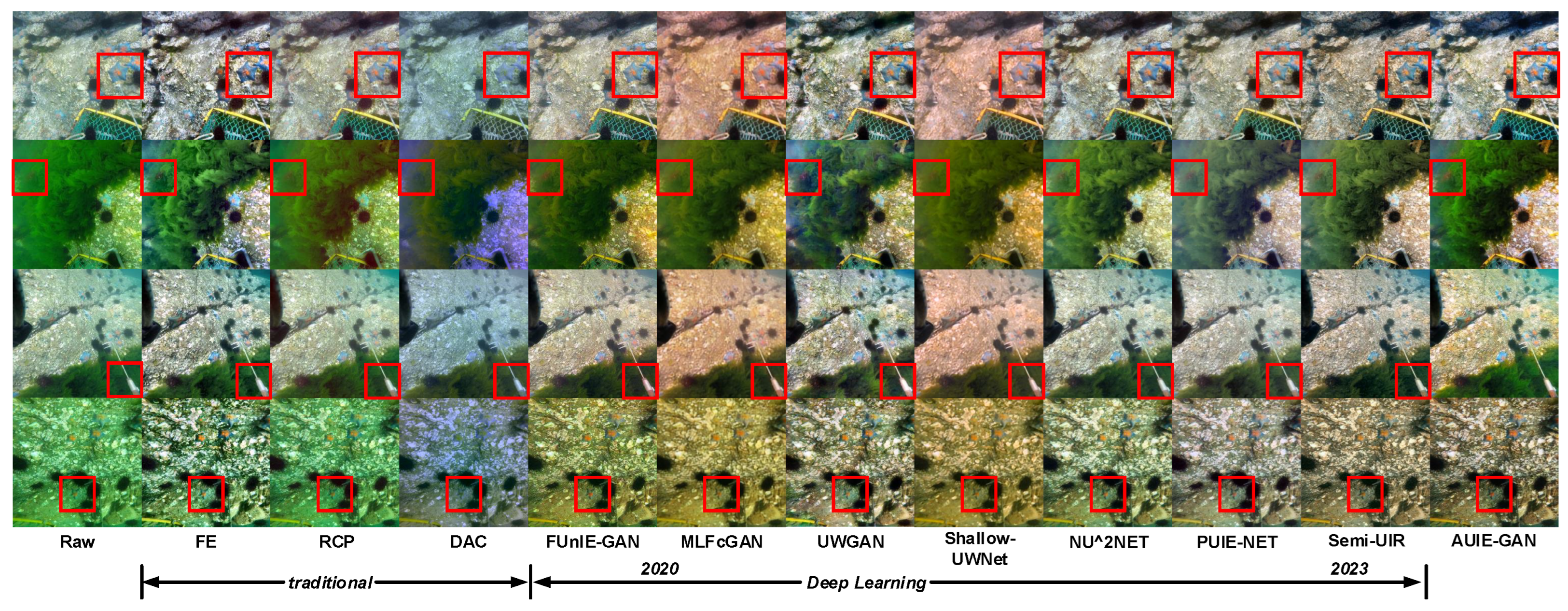


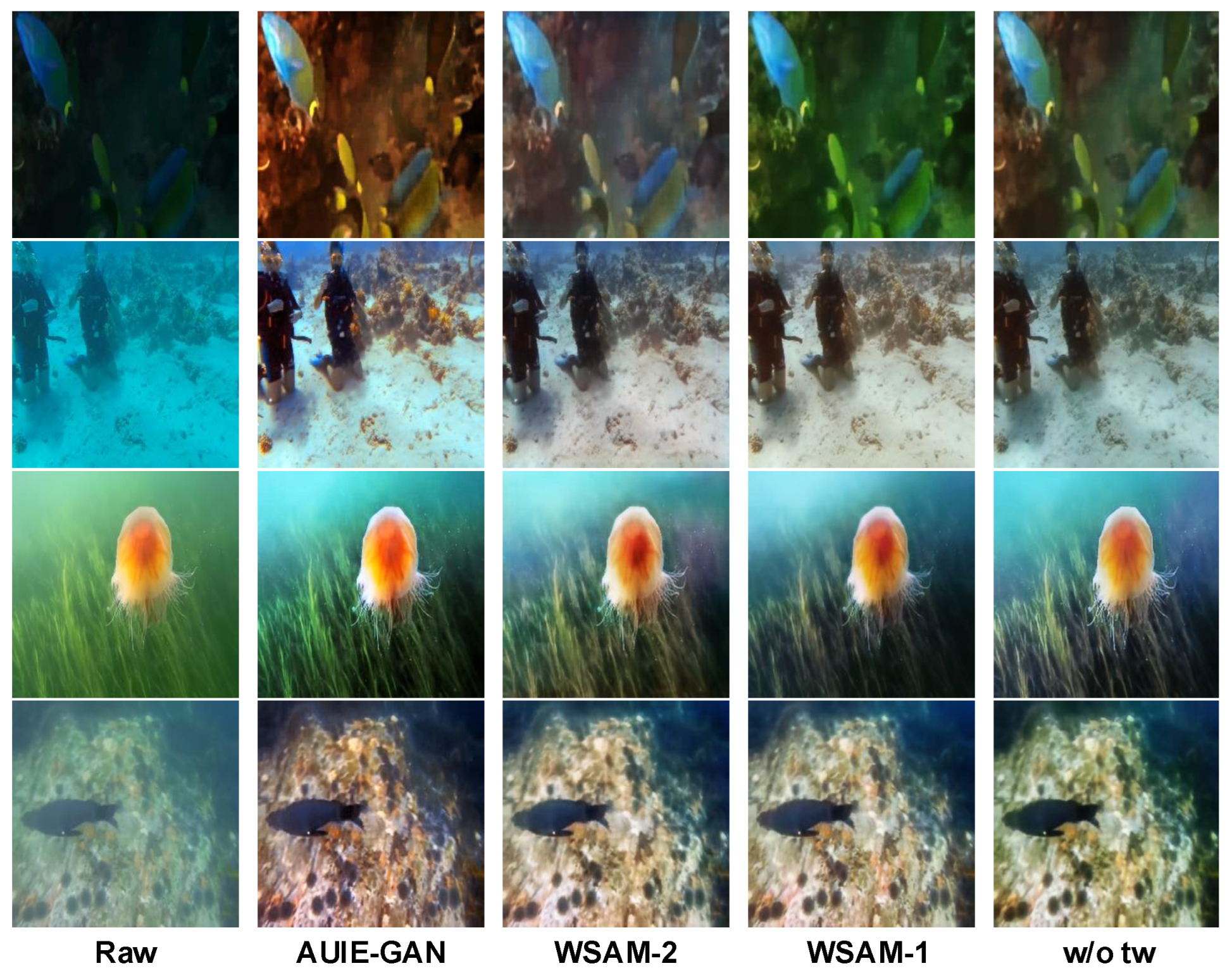
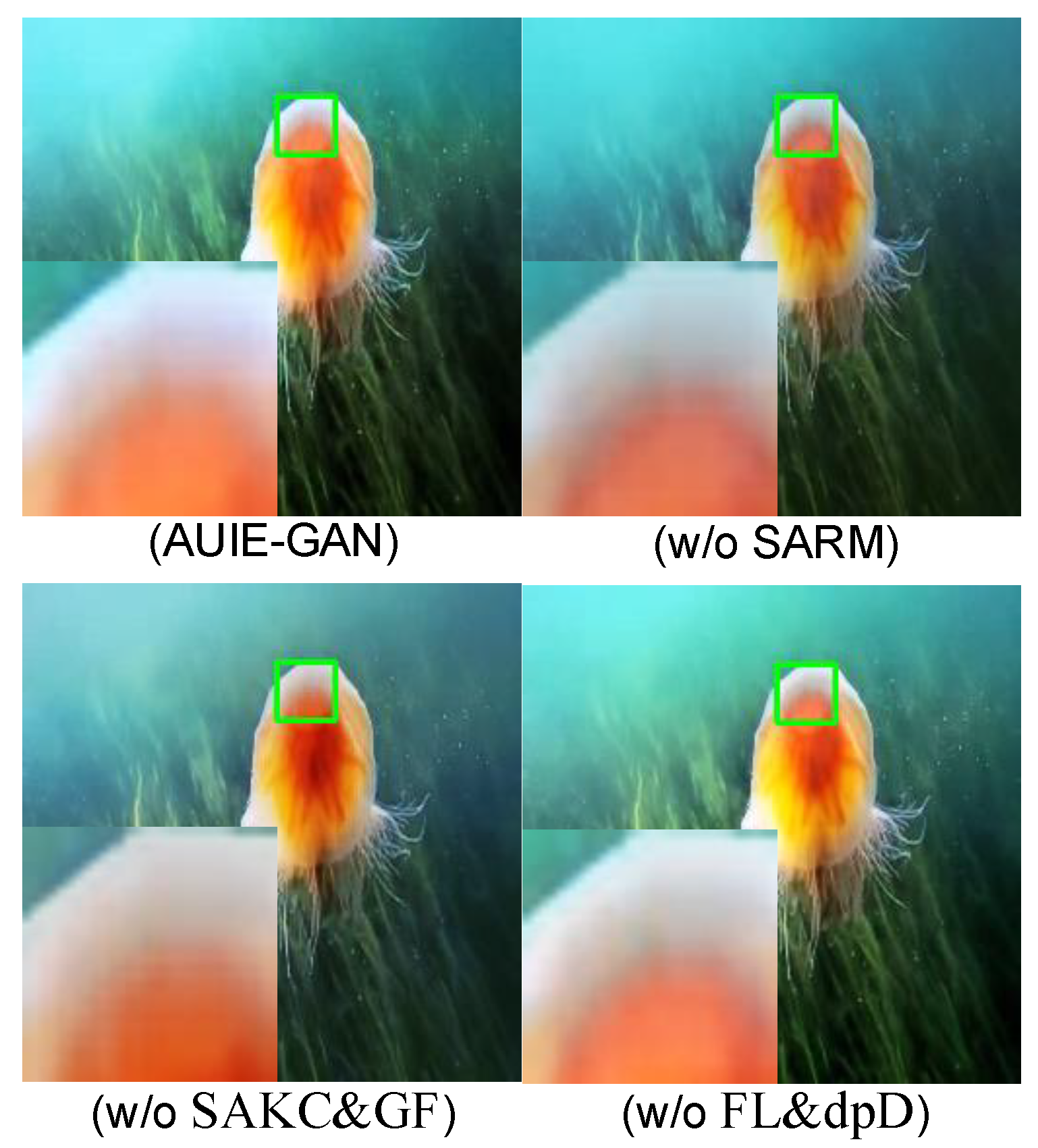

| Baselines | PSNR | SSIM |
|---|---|---|
| Raw | 12.2289 | 0.7598 |
| FE (2012) | 20.3589 | 0.8007 |
| RCP (2015) | 20.2441 | 0.8780 |
| DAC (2022) | 13.8407 | 0.7531 |
| FUnIE–GAN (2020) | 16.2501 | 0.8058 |
| MLFcGAN (2020) | 13.7275 | 0.5767 |
| UWGAN (2020) | 28.7628 | 0.9138 |
| Shallow–UWNet (2021) | 14.4293 | 0.6985 |
| NUˆ2NET (2022) | 23.2156 | 0.9300 |
| PUIE–NET (2022) | 19.6275 | 0.9028 |
| Semi–UIR (2023) | 22.3050 | 0.9192 |
| AUIE–GAN (ours) | 29.1992 | 0.9302 |
| Baselines | UIQM | UCIQE | ||||
|---|---|---|---|---|---|---|
| U45 | Challenge60 | RUIE | U45 | Challenge60 | RUIE | |
| RAW | 2.3821 | 2.9388 | 3.6634 | 0.3754 | 0.3590 | 0.3571 |
| FE | 4.1226 | 4.3528 | 4.8685 | 0.4791 | 0.4782 | 0.4464 |
| RCP | 3.5829 | 4.1845 | 4.7307 | 0.4365 | 0.4243 | 0.4047 |
| DAC | 3.6855 | 3.7572 | 4.8680 | 0.3274 | 0.3049 | 0.3354 |
| FUnIE–GAN | 4.3503 | 4.2946 | 5.3997 | 0.4000 | 0.3592 | 0.3633 |
| MLFcGAN | 4.2029 | 4.2923 | 5.3902 | 0.3909 | 0.3681 | 0.3740 |
| UWGAN | 3.9840 | 4.2963 | 5.4074 | 0.4836 | 0.5043 | 0.3887 |
| Shallow–UWNet | 4.0523 | 4.1125 | 5.3939 | 0.3704 | 0.3348 | 0.3719 |
| NUˆ2NET | 4.3921 | 4.4623 | 5.3521 | 0.4186 | 0.4125 | 0.4088 |
| PUIE–NET | 4.2863 | 4.0633 | 5.1813 | 0.3874 | 0.3772 | 0.3820 |
| Semi–UIR | 4.5154 | 4.3051 | 5.0206 | 0.4283 | 0.4357 | 0.4041 |
| AUIE–GAN | 4.7409 | 4.6346 | 5.4136 | 0.4844 | 0.5179 | 0.4326 |
| Baselines | Blue | Green | Hazy | Low-Light | ||||
|---|---|---|---|---|---|---|---|---|
| UIQM | UCIQE | UIQM | UCIQE | UIQM | UCIQE | UIQM | UCIQE | |
| RAW | 2.1982 | 0.4229 | 1.8274 | 0.3857 | 3.7035 | 0.2788 | 4.2557 | 0.3322 |
| FE | 3.7578 | 0.4943 | 4.1200 | 0.4702 | 4.7638 | 0.4621 | 5.0450 | 0.4719 |
| RCP | 3.4218 | 0.4579 | 3.3204 | 0.4190 | 4.7891 | 0.4134 | 4.9475 | 0.3943 |
| DAC | 3.6714 | 0.3600 | 3.6919 | 0.3414 | 3.4419 | 0.2312 | 4.5746 | 0.2912 |
| FUnIE–GAN | 3.6850 | 0.3992 | 4.5069 | 0.3848 | 4.8411 | 0.3452 | 4.8492 | 0.3449 |
| MLFcGAN | 3.6804 | 0.3935 | 3.9696 | 0.3408 | 5.1186 | 0.3865 | 4.8290 | 0.3884 |
| UWGAN | 3.4863 | 0.4247 | 4.1250 | 0.3808 | 4.6873 | 0.4020 | 5.4309 | 0.4413 |
| Shallow–UWNet | 3.5399 | 0.3616 | 4.0139 | 0.3249 | 4.6907 | 0.3536 | 4.7070 | 0.3445 |
| NUˆ2NET | 4.0057 | 0.4295 | 4.4596 | 0.4052 | 4.7934 | 0.4124 | 4.9543 | 0.4028 |
| PUIE–NET | 3.7370 | 0.3888 | 4.2769 | 0.3818 | 4.4543 | 0.3783 | 4.6661 | 0.3713 |
| Semi–UIR | 3.8503 | 0.4312 | 4.6147 | 0.4113 | 4.6627 | 0.4422 | 5.1683 | 0.4611 |
| AUIE–GAN | 4.1562 | 0.4904 | 4.6068 | 0.4699 | 4.7696 | 0.4963 | 5.9332 | 0.5360 |
| Raw | WSAM-1 | WSAM-2 | w/o tw | AUIE–GAN | |
|---|---|---|---|---|---|
| UIQM | 2.9388 | 4.1141 | 4.3672 | 4.2390 | 4.6346 |
| UCIQE | 0.3590 | 0.4133 | 0.4104 | 0.4173 | 0.5179 |
Disclaimer/Publisher’s Note: The statements, opinions and data contained in all publications are solely those of the individual author(s) and contributor(s) and not of MDPI and/or the editor(s). MDPI and/or the editor(s) disclaim responsibility for any injury to people or property resulting from any ideas, methods, instructions or products referred to in the content. |
© 2023 by the authors. Licensee MDPI, Basel, Switzerland. This article is an open access article distributed under the terms and conditions of the Creative Commons Attribution (CC BY) license (https://creativecommons.org/licenses/by/4.0/).
Share and Cite
Guan, F.; Lu, S.; Lai, H.; Du, X. AUIE–GAN: Adaptive Underwater Image Enhancement Based on Generative Adversarial Networks. J. Mar. Sci. Eng. 2023, 11, 1476. https://doi.org/10.3390/jmse11071476
Guan F, Lu S, Lai H, Du X. AUIE–GAN: Adaptive Underwater Image Enhancement Based on Generative Adversarial Networks. Journal of Marine Science and Engineering. 2023; 11(7):1476. https://doi.org/10.3390/jmse11071476
Chicago/Turabian StyleGuan, Fengxu, Siqi Lu, Haitao Lai, and Xue Du. 2023. "AUIE–GAN: Adaptive Underwater Image Enhancement Based on Generative Adversarial Networks" Journal of Marine Science and Engineering 11, no. 7: 1476. https://doi.org/10.3390/jmse11071476
APA StyleGuan, F., Lu, S., Lai, H., & Du, X. (2023). AUIE–GAN: Adaptive Underwater Image Enhancement Based on Generative Adversarial Networks. Journal of Marine Science and Engineering, 11(7), 1476. https://doi.org/10.3390/jmse11071476






